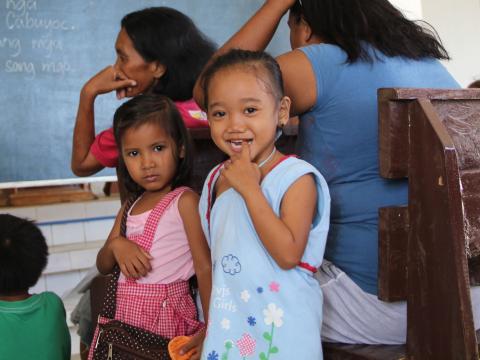Leaving tent city for home

Family members dismantle worn-out tents that have turned dirty white from dust and mud while withstanding months of extreme weather brought by scorching sun and lashing rains. Mothers and fathers carry their children in an exodus from a place they’ve stayed for the last three months, bringing with them a few salvaged belongings and relief items that they've managed to hold on to. They are heading home to their makeshift houses -- places being rebuilt from salvaged wood, tin sheets and tarpaulins.
When they arrive at their former homes, now sites of destruction, they’re reminded of that grim day when their homes were brutalized by fierce rains and winds. The gale was so strong a barge went rampaging ashore, leaving an oil spill that engulfed the sea with black crude, further damaging livelihoods of the many involved in the fishing trade and leaving a lethal stain of grime behind.
There is a mass exodus underway, from tent city, towards homes being rebuilt from ruins.
Maricel Guardario, 34 years old, shares, "We have relied on the sea's bounty for as far as I could remember. Now, my husband had to resort to menial work and irregular carpentry jobs to augment for the low income that he gets from fishing."
Panay was the second-hardest hit island from Typhoon Haiyan’s rage. Around 15.5 billion pesos (est. US $360 million) worth of damages in infrastructure and agriculture come from the heavy devastation in the island inhabited by more than 4 million people.
Fisherfolk are still reeling from the losses brought by lower fish catch in Estancia's troubled waters. Government clean-up drives have since helped mitigate environmental damages of the oil spill. But going back to their homes is not an easy task.
"I still worry about our future; raising five children in this environment would be difficult. I always worry about the safety of my children," Maricel says.
Rebuilding begins
World Vision’s rebuilding efforts are now focused in providing shelter assistance for around 2,000 people in Panay. A sustainable livelihood program is also on the way to provide opportunities for skills training to restore farms and fishing trade and provide families income opportunities that would give them more income.
The government is still looking for a suitable relocation site for the displaced families who have nowhere to go, their devastated houses now lie in government declared no-build zones, off-limits to human settlements because of the foreseen danger that future disasters could bring.
Some 90 families remain in the tent city in a vacant lot inside a local college. World Vision is coordinating with the government in identifying alternative sites where people could rebuild their houses.
Relocating the school is also one of the identified priorities in the community.
In Botongon, Estancia and in other highly devastated areas, World Vision is working with the community to set up temporary learning spaces. For now children are holding classes in a partially damaged church. Classes are held three days a week with hours shortened to give way to six different grade levels with more than 100 students sharing the space.
"The oil spill is gone but the stench can be smelled in the school grounds especially when the sun hits its peak in the afternoon. It can get unbearable especially for children and may post health risks to them." explains Charlie Samillano, World Vision staff. Consultations with teachers were held and one of the primary issues that were raised is children's safety.
A suitable lot was identified in coordination with the local government and school management and now parents and local village leaders and volunteers are mobilizing to clear the land and set up tents.
Doctor Yvonne Duque, manager of the Child well-being team says "There is a need to ensure that schools are safe for the children as we head to the recovery phase of the emergency response. Temporary learning spaces should be set-up in areas where schools remain damaged.”
These learning spaces would further improve school attendance in areas that are heavily hit by the typhoon. In Botongon, school attendance is already at 90 percent since January, with three schools registering good student attendance.
"I still worry about our future; raising five children in this environment would be difficult. I always worry about the safety of my children," Maricel says.
“Before, children would immediately run and head home at the first sign of rains but now children are braving rainy days and would even walk in muddy roads just to be in class," Samillano adds.
Annalyn Alenton, Education Specialist, says, "Aside from school repairs, we are also working with the school teachers and equip them to provide psychological first aid to be able to deal with children who still need regular counseling."
"As we usher families back to their homes, more work needs to be done in their communities. We are looking into providing resiliency and life skills training for the families to get extra income as well. Parent and teacher associations could be tapped for cash-for-work activities that involve school repairs, community-based construction trade and rehabilitation of fishing and farming in devastated areas," Alenton concludes.